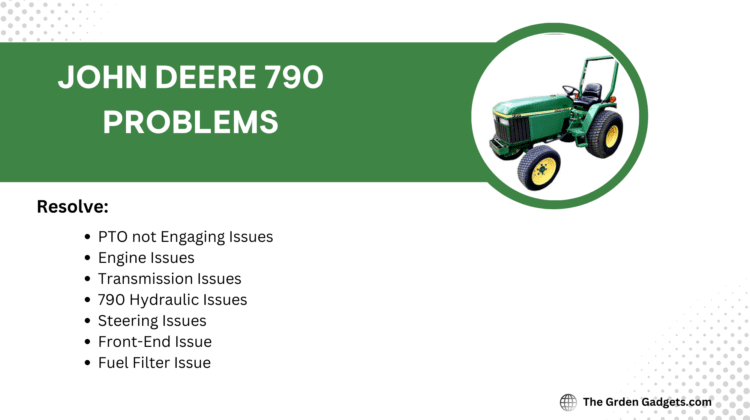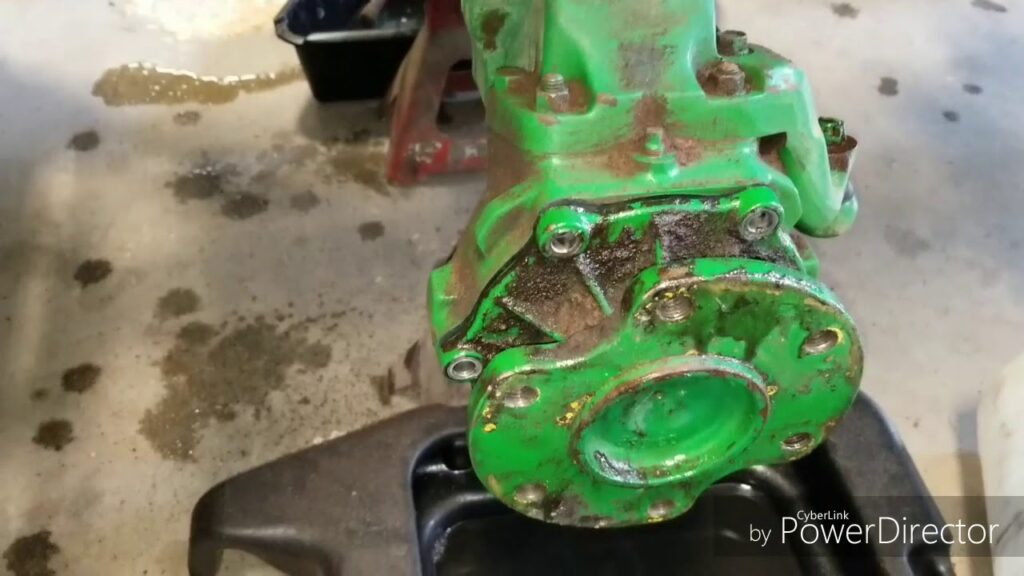
For individuals searching for a machine that can handle all their typical ranching and agricultural needs, the John Deere 790 is the ideal utility tractor. JOHN DEERE is always at the top of the list for managing large lawns. Even so, there will be issues that prevent you from cutting, despite their dependability. Let’s go over some alternative solutions for a continuous mowing experience in case you aren’t familiar with fixing the problems with this mower.
It’s crucial to understand the signs of a faulty PTO clutch if you’re having issues with your PTO clutch, starting problems, or electrical issues. In this manner, you can decide if your problems need to be fixed or changed.
1- PTO Clutch
The PTO clutch (Power Take Off) offers a way to manually detach the engine from the blades. The clutch engages the drive belt to drive the rotation of the lawn mower blades when the clutch solenoid is activated. The lawnmower blades won’t engage if the PTO clutch isn’t receiving power, the clutch solenoid is broken, or the clutch is worn out.
Solution
If the PTO clutch is broken, you must replace it because it cannot be repaired.
2- PTO Switch
The PTO clutch is powered by the PTO switch. If the switch is broken, the PTO clutch might not get power. The lawn mower blades won’t turn as a result, and the clutch won’t engage.
Solution
Test the switch’s continuity using a multimeter to see if it is damaged. Replace the PTO switch if necessary.
3- Grinding Noise when PTO Engages:
When the PTO is engaged, if you hear a whirring or grinding noise, your PTO clutch probably is not lubricated. The noise is most likely being produced by internal gears rubbing against one another.
Solution
Your PTO Clutch needs lubrication.
4- Fluid Leaks from the PTO
Smaller leaks are a sign that the machine needs more lubrication. The gears may wear out more quickly in the absence of lubrication, which could eventually result in additional issues.
Solution
To resolve this issue, extra oil or grease must be added to the appliance
John Deere 790 Engine Issue with Solution
1- difficult to Start or doesn’t Start:
The reason of engine is difficult to start can dirty fuel filter. Damaged or dirty injection nozzles.
Solution
Change filter element. Air in the fuel system. Air bleeding. Check injection nozzles and replace them if required. Defective fuel injection pump. Rebuild or replace the pump.
2- Unexpected engine shutdown while running
Incorrect fuel injection pump timing adjustment, lockage of the fuel filter element, and the cold engine can be reasons behind the sudden shutdown of the engine while running.
Solution
Adjust fuel injection as advised in the manual. Switch out the filter element. Warm up the engine as necessary.
3- Sudden Stalling
Some of our users can experience the problem of unexpected stalling of the engine. The reason behind this can be Fuel filter is blocked, the fuel injection pump is damaged, or restricted air intake.
Solution
Maintain the filter. Change or fix the injection pump. Alternate the air filter element.
4- Engine Overheating
Your engine overheating may be caused by clogged air cleaners, blocked intake screens or air channels, low engine coolant levels, low engine oil, blocked cooling fins, or a loose or damaged fan belt.
Solution
Clean the radiator or replace the top. Fill to the proper level and check for leaks in the system. If required, change the belt. Insufficient engine oil is present. checking the oil level and adding more as needed.
5- Engine stops when running:
The low idle speed that was incorrectly adjusted, valves’ clearances not altered, or the fuel injection pump malfunctioning can be the reasons the engine stops when running.
Solution
Adjusting the low idle correctly. Changing valve clearance is necessary. Replace or rebuild the fuel pump.
John Deere 790 Transmission Issue with Solution
1- Transmission Noise
While the tractor is driving, transaxle gears frequently emit a faint whining sound. This is typically more apparent with new tractors or transmissions. The gear teeth rubbing against one another inside the transaxle case is what causes this noise. With time, this noise should diminish as the gears slightly deteriorate.
Solution
Repair broken gears or appropriately adjust backlash. Shift forks must be replaced. Refill the transmission fluid after checking it. To replace the bearings. Adjust the fluid. We advise having the item inspected by an authorized service centre if the noise suddenly gets louder.
2- Hard to Shift Gears
Without enough lubrication, the transmission’s gears may become hesitant and difficult to move. Or the Troy-Bilt lawn tractor’s gears could occasionally experience mechanical issues. Users are advised by Troy-Bilt to avoid pushing the shift lever into gear since doing so could permanently harm the transmission. When the clutch is depressed, the drive belt releases tension on the transaxle; a belt that sticks might lead to shifting issues.
Solution
Lubricate or replace the shift linkage. If necessary, adjust the clutch or replace it. Replace the shift forks. Check the belt for any issues-causing cracks, tears, or wear, and replace the drive belt as necessary.
3- Low Transmission Level
Maybe there is a lack of transmission fluid. The relief valve can be locked. A blocked transmission fluid filter can also be a problem at low transmission levels.
Solution
Refill the transmission fluid after checking it. Change or maintain the transmission fluid filter. Change the valve.
4- Transmission Oil Leakage
There are numerous seals in the transmission of your lawn mower. These seals deteriorate over time, and depending on where the damaged seal is positioned, fluid may leak from the driveshaft, input shaft, output shaft, or other transmission sections. Over time, the transmission pan gasket may also deteriorate and start to permit transmission fluid to pass through. Your pan gasket’s improper installation may also be the cause of a transmission fluid leak.
Solution
Gaskets and seals must be replaced to resolve this issue.
John Deere 790 Hydraulic Issue with Solution
1- Hydraulic System Overheats
Temperatures of hydraulic fluids above 180°F (82°C) harm most seal compounds and hasten oil deterioration. The reason for a hydraulic system getting heated can be Inappropriate hydraulic oil type, Hydraulic oil pollution, Air in hydraulic lines, or the Main relief valve can be malfunctioning.
Solution
Use only the right kind of hydraulic oil. If the oil is contaminated, replace it. If hydraulic lines contain air, bleed them. Change the relief valve if it is faulty.
2- Insufficient hydraulic oil pressure:
Inadequate hydraulic fluid, a clogged hydraulic oil filter element, leaking hydraulic lines, an improperly adjusted hydraulic control valve, a failed hydraulic pump, or a malfunctioning hydraulic cylinder can all contribute to low hydraulic oil pressure.
Solution
As needed, add fluid. Replace the hydraulic filter element or clean it. Fix leaks and inspect the hydraulic system. Correctly adjust the hydraulic control valve. Pump for hydraulic fluid repair or replacement. Hydraulic cylinder should be fixed or replaced.
John Deere 790 Steering Issue with Solution
1- Unnecessary steering wheel free play
Reason for steering wheel to unnecessary free play can be because of worn coupler or steering column shaft, faulty steering pump, the steering linkage unit is worn or faulty, or the steering column has worn or damage.
Solution
Repair the broken component. If necessary, inspect the steering pump and replace it. steering linkage should be fixed or replaced. Check and replace as necessary.
2- John Deere 790 is pulling to right or left
Because of wear or damage, the steering metering unit on a John Deere is pulling to the right or left. Number of reasons behind this for example wear on the steering cylinder, improper toe-in, the steering linkage unit is worn or faulty, the bearings in the front wheels are faulty or worn out, or erratic tyre pressure.
Solution
As necessary, replace or repair the steering unit. Change or fix the steering cylinder. Ensure adequate toe-in. Verify and adjust as necessary. Correct the adjustment or substitute new bearings. Properly inflate the tyres.
John Deere 790 Front-End Issue
John Deere Front-End Issue
Most users experience issues with the front-end loader. It requires a stronger setup, so you don’t have to face the issue of front end.
Solution
Taking the Front Loader Off the Hook
When contrast to attaching, the Loader requires a few more steps to remove, and these extra actions are all related to preparing the tool for usage again. You might have to put in a few extra minutes of labor, but when the reattachment procedure is complete, you’ll be glad you did.
Linking up the Front Loader again
Since the Front Loader was already removed, reattaching it should be a quick and simple process that allows you to resume working immediately.
John Deere 790 Fuel Filter Issue
There are situations when the oil flow to the engine is improper. The strainer becomes blocked. The debris falls off when the engine shuts off until it is sucked back across the strainer. Another idea is a gasoline line with a tiny pinhole that, when the vacuum is high enough, allows air to enter.
Solution
It is important to inspect both the injector pump and the lift pump that supplies it. The tank is on top of the 790. Hence, drain it, remove it, and make sure there was no debris within. Once the strainer has been cleaned, unplug the filter’s supply lines and blow up compressed air through them.
JOHN DEERE 790 FRONT AXLE DIAGRAM

Conclusion
The secret to appropriate maintenance is to keep your John Deere in check. Knowing the issues with the John Deere 790 will make it simple for you to resolve them. However, keep in mind that frequent maintenance is necessary for every part of a tractor to ensure excellent performance.
Frequently asked questions ()
Hy-Gard
Make sure Hy-Gard is installed. John Deere engineers prefer Hy-Gard to give improved performance and protection of transmission and hydraulic systems both in the lab and on the job. Thanks to its polymeric viscosity improver, Hy-Gard maintains optimum viscosity over a wide range of working temperatures.
Deere Plus-50 II 15W40 Oil, 2.7 L, should be added to the machine’s crankcase. Start the engine, then look for leaks.
· Schematic of the John Deere hydraulic system
· With the implements down, park the tractor on a flat surface.
· Run the engine for at least one minute at a speed of about 1000 rpm. Wait three minutes for the oil to settle after stopping the engine.
· Look via sight glass (A) to the oil level.
· You must add oil if the level is below the lower point.
Leave a Reply